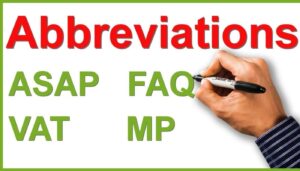Abbreviations are like shortcuts in communication small, efficient tools that help us express ideas quickly and clearly. Whether it’s in emails, business forms, or everyday texting, they save us time and space. One abbreviation you’re likely to encounter is for the word “Received.” You might have seen it pop up in an invoice, a shipping receipt, or an email confirming a payment. But what exactly does it mean, and how do we use it effectively?
In this article, we’ll explore everything you need to know about the abbreviation for “Received,” how it came to be, and why it’s so commonly used. We’ll also provide practical tips on when to use it, its different forms, and helpful examples. By the end, you’ll have a clear understanding of this helpful abbreviation and be able to use it confidently in your own communication.
What is the Abbreviation for “Received”?
The word “Received” is often shortened in written communication to save time, especially in professional or business settings. There are two primary abbreviations that are commonly used:
- Rec’d
- Rcvd
Both abbreviations serve the same purpose: to make the word “Received” more concise while still conveying the same meaning. Let’s break down both forms to help you understand when to use each one.
1. Rec’d: The Most Common Abbreviation
The abbreviation Rec’d is by far the most widely used form. It’s a short, simple way of saying “Received,” with the apostrophe indicating that letters have been omitted. It’s particularly useful when you need to communicate quickly and professionally.
Example Usage of “Rec’d”:
- “Rec’d payment for invoice #456.”
- “Rec’d your message and will reply shortly.”

The apostrophe in Rec’d is similar to other abbreviations like “Gov’t” for “Government” or “O’Clock” for “Of the Clock.” It’s a compact form that makes communication smoother without losing clarity.
2. Rcvd: The Streamlined Option
The abbreviation Rcvd drops even more letters, eliminating the vowels in the middle of the word. It’s a more streamlined version of Rec’d, commonly used in industries that prioritize brevity, like logistics and project management.
Example Usage of “Rcvd”:
- “Rcvd your shipment on Tuesday.”
- “Rcvd email confirmation for the meeting.”
Since Rcvd is shorter, it’s perfect for situations where you need to save space—such as filling out shipping forms, invoices, or spreadsheets.
Why Use Abbreviations for “Received”?
Abbreviations like Rec’d and Rcvd are commonly used in professional communication because they save both time and space. Imagine sending multiple emails, invoices, or shipping updates each day. Writing out “Received” every time can become tedious. By using an abbreviation, you can convey the same message in a much more efficient manner.
Additionally, abbreviations are particularly helpful in environments where clarity and speed are critical. For example, if you’re managing a high-volume shipping department, it’s much quicker and easier to write “Rcvd” than to spell out “Received” in every record.
When Should You Use “Rec’d” vs “Rcvd”?
Both abbreviations are useful, but there are subtle differences in their tone and context. Here’s a simple guide on when to use each:
- Rec’d: Use Rec’d when you want a more formal tone, or when you’re working with documents where professionalism is key. It’s ideal for business letters, financial records, and invoices.
- Rcvd: Use Rcvd in more utilitarian settings where brevity and speed are prioritized. This could be in internal memos, shipping forms, or project management records.
Common Contexts for Using the Abbreviation “Received”
Abbreviations for “Received” show up all over the place in business and personal communication. Let’s look at some common scenarios where you might use Rec’d or Rcvd:
1. Business Emails
In business correspondence, where clarity and brevity are crucial, you’ll often see Rec’d in the subject line or body of the email. It’s especially helpful for confirming receipt of important documents, payments, or requests.
- Example: “Rec’d your payment of $500. Thank you!”
- Example: “Rec’d your proposal, and we’ll review it shortly.”
2. Shipping and Logistics
In logistics or shipping departments, Rcvd is frequently used to confirm the arrival of packages or shipments. It’s an efficient way to track deliveries in forms, records, and invoices.
- Example: “Rcvd shipment of 100 units on 10/14.”
- Example: “Rcvd order from Supplier A—shipped on 10/12.”
3. Payment Confirmation
When dealing with payments or financial transactions, it’s important to confirm receipt quickly. Both Rec’d and Rcvd are commonly used to record payments, ensuring the sender knows their transaction has been successfully processed.
- Example: “Rec’d payment for Invoice #1234. Thank you!”
- Example: “Rcvd wire transfer for the amount of $2,500.”
4. Internal Records and Documentation
In workplace environments, Rec’d and Rcvd appear frequently in internal documents or records, where they help track the flow of information or goods. For instance, you might see these abbreviations in meeting minutes, project tracking sheets, or inventory logs.
- Example: “Rec’d approval from department head on 11/12.”
- Example: “Rcvd email from client with feedback.”
Helpful Tips for Using Abbreviations
Using abbreviations like Rec’d and Rcvd can save you time, but there are a few tips to ensure they’re used correctly:

1. Be Mindful of Your Audience
While abbreviations are efficient, they may not always be appropriate in every context. If you’re writing a formal letter or report, spelling out the full word “Received” might be better to maintain a more professional tone. If you’re unsure, err on the side of formality.
2. Consider the Medium
Abbreviations are perfect for places with limited space, such as subject lines in emails, shipping forms, or spreadsheets. However, in detailed reports or communications where the full meaning is important, spelling out “Received” is usually best.
3. Use Abbreviations Consistently
If you decide to use an abbreviation in a document, ensure you use it consistently throughout. Switching between Rec’d and Rcvd within the same document can confuse readers. Choose one and stick with it.
Synonyms and Antonyms for “Received”
In any form of communication, having a variety of vocabulary options is helpful. Instead of always using “Received,” here are a few synonyms and antonyms you can consider:
Synonyms for “Received”:
- Accepted
- Obtained
- Acquired
- Collected
Antonyms for “Received”:
- Sent
- Dispatched
- Delivered
- Given
For example, instead of saying “I received the package,” you could say “I accepted the delivery,” or “I obtained the shipment.”
The History of the Word “Received”
Understanding the history of a word can provide valuable insight into its meaning and usage. The word Received comes from the Latin root “recipere,” meaning “to take back” or “to accept.” Over time, the word evolved through Old French and Middle English, maintaining the core meaning of taking or accepting something.
The concept of receiving—whether it’s an item, payment, or information—has been consistent throughout history, which is why the word Received remains so relevant today.
Why Abbreviations Matter in Professional Communication
Abbreviations like Rec’d and Rcvd do more than just save space; they signal a level of professionalism in certain environments. Using these abbreviations effectively shows that you are familiar with business conventions and understand how to communicate efficiently.
Moreover, abbreviations reduce ambiguity. In environments where fast communication is crucial, such as project management or logistics, abbreviations make it clear that a delivery or payment has been received, without needing to elaborate on the details.
Final Words
In conclusion, abbreviations like Rec’d and Rcvd are not just time-savers—they’re valuable communication tools that streamline information, improve efficiency, and maintain professionalism. Understanding when and how to use them will help you navigate both formal and informal communication with ease.
As with any tool, it’s essential to use abbreviations thoughtfully. Be mindful of your audience and context, and you’ll find that these little shortcuts can make a big difference in your day-to-day communication.









